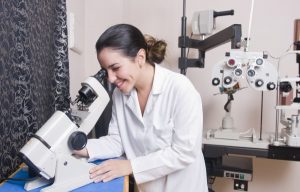Researchers have developed the first instrument that will provide a detailed image of the entire eye. Incorporating a lens that changes optical parameters in response to electric currents, the radically new technology can produce higher quality images than currently available. Combining optical coherence tomography and an electrically actuated tunable lens will change the way medical professionals can ‘see’ into the eye. Optical coherence tomography has become a standard technique in ophthalmology, thanks to its easy fit with clinical workflows and the ability to image particular zones of the eye, such as the anterior chamber and the cornea.
Optical coherence tomography has become a standard technique in ophthalmology, thanks to its easy fit with clinical workflows and the ability to image particular zones of the eye, such as the anterior chamber and the cornea.
Use of the same technique to image the whole eye has proved challenging. OCT’s limited imaging depth can be improved through Fourier domain methods and use of modern swept-source laser sources, but the optics of the eye prevent the focusing of light on both the anterior chamber and the retina simultaneously without sacrificing resolution.
A project from Poland’s Nicolaus Copernicus University and a group at the University of Murcia in Spain led by Pablo Artal has now developed a possible solution, a platform combining swept-source OCT and an electrically tunable lens (ETL) that allows imaging and biometry of the whole eye.
“Although there have been trials reported in the past on the application of ETLs in OCT, we have carried out a thorough investigation of ETL performance in different designs of OCT system, and demonstrated how image quality can be improved when focus tuning is applied.” said Ireneusz Grulkowski of Nicolaus Copernicus University.
“We also showed for the first time that it is possible to compensate for the light refraction in the eye, and therefore possible to combine two optical configurations – one for imaging of the anterior segment and a second for retinal imaging – in one simple design. Previous attempts at whole-eye imaging have used two separate illumination beams, but our approach is based on switching the focus between the front and the back of the eye.”
The OCT system also incorporated a newly commercialized swept light source — a laser that continuously changes wavelength very rapidly. The wavelength-tunable laser improves the resolution and speed of OCT compared to systems that use other light sources. The researchers integrated high-speed electronics to achieve the imaging depth necessary to enable whole eye imaging.
Universe Optics designs and creates precision tunable lenses that can be incorporated into this cutting-edge instrumentation. All of the required specifications are met to ensure the clearest, most precise image possible.
“Diseases such as glaucoma affect both the front and back portions of the eye,” said Ireneusz Grulkowski, whose research team at Nicolaus Copernicus University, Poland, worked with Pablo Artal’s team to develop the new imaging system. “An instrument that can examine the whole eye will improve the patient’s experience because they won’t have to go through imaging with different devices. It might also one day reduce the number of instruments — which can be quite expensive — needed in an ophthalmology clinic.”
Although the laboratory version of the set-up is ready to use, further steps will be taken to translate the technology to the clinic. The scientists are focused on optimizing the scan areas and developing processing tools for automatic measurement of the dimensions of the eye. These improvements will enable advanced studies of the proposed scan regimes on a group of patients with different types of opacification in the eye.